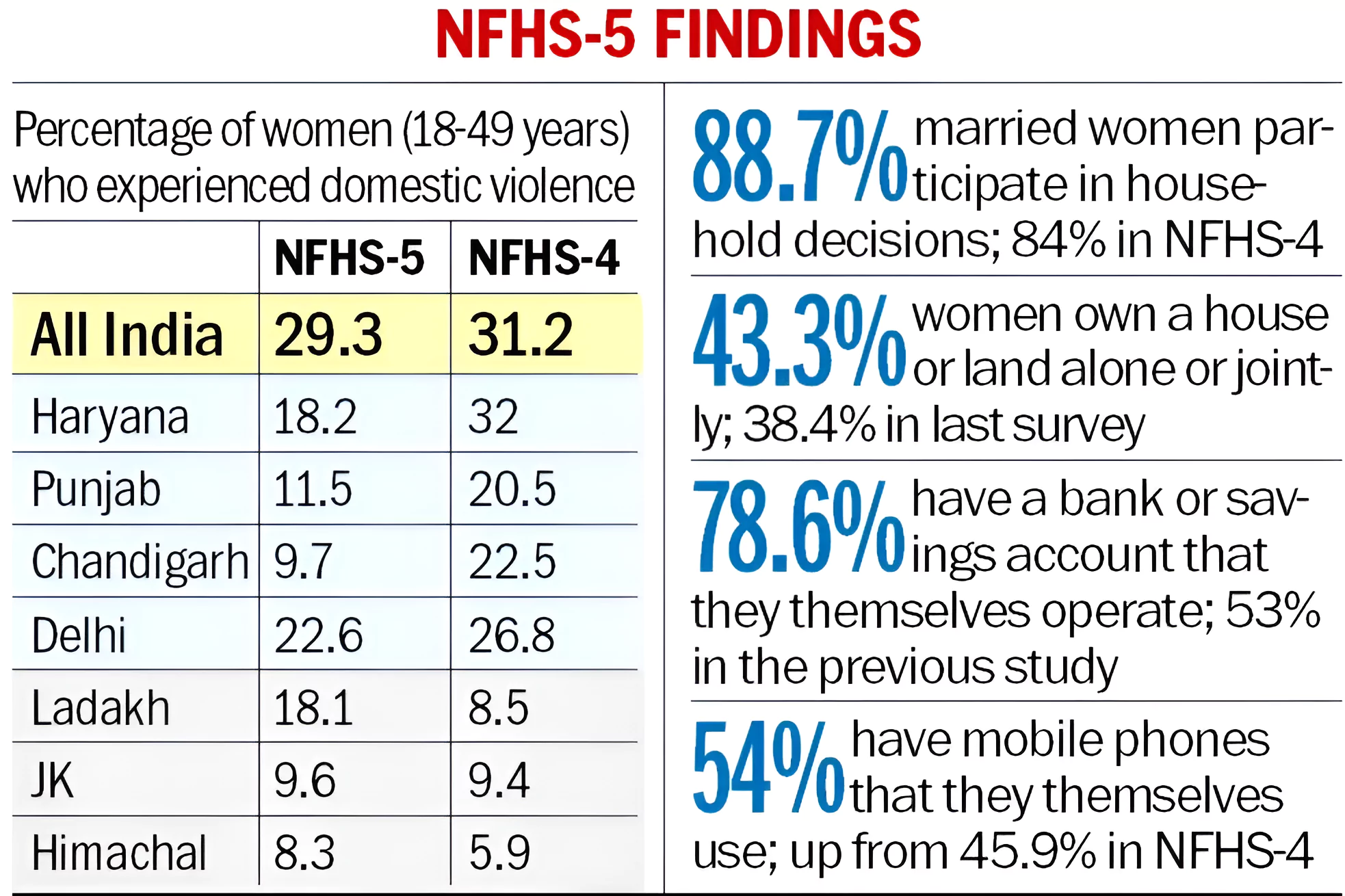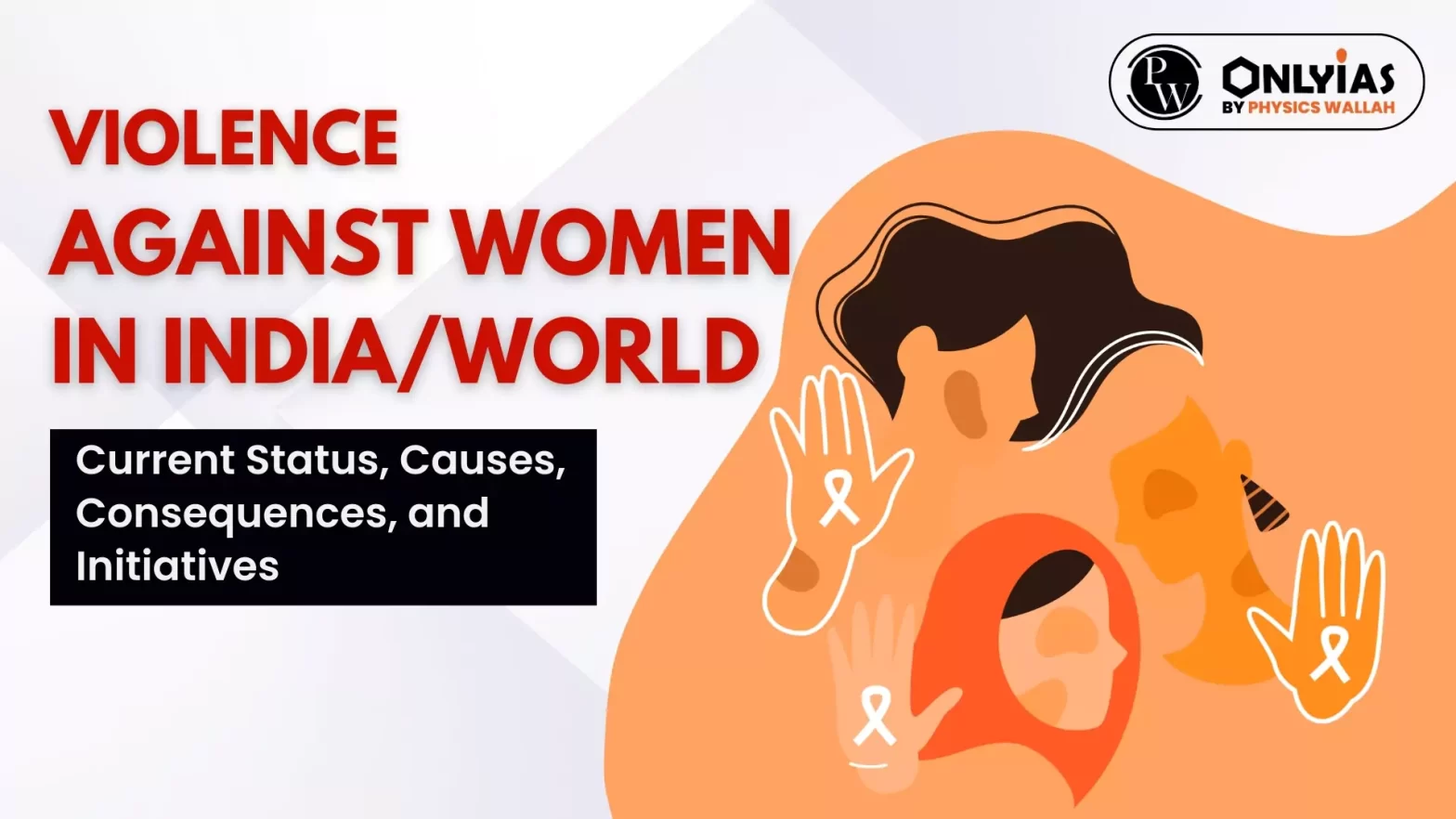Context
The National Family Health Survey (NFHS-5) presents a concerning picture of the pervasive violence against women in India, highlighting its intersection with mental health conditions and homelessness.
Violence Against Women
- Definition: The UN defines violence against women as “any act of gender-based violence’ that results in or is likely to result in, physical, sexual or mental harm or suffering to women, including threats of such acts, coercion or arbitrary deprivation of liberty, whether occurring in public or in private life”.
- Occurrence: The issue of violence against women occurs throughout the life cycle from pre-birth, infancy, childhood, adolescence, adulthood to old age.
- A Matter of Concern: The issue of violence against women is a social, economic, developmental, legal, educational, human right and health (physical and mental) issue.
- It is a human rights violation, and the immediate and long-term physical, sexual, and mental consequences for women and girls can be devastating, including death.
About the National Family Health Survey (NFHS)
- A large-scale, multi-round survey conducted in a representative sample of households throughout India, with an objective to collect reliable and up-to-date information.
- Conducted by: The Ministry of Health and Family Welfare (MoHFW).
- Nodal Agency: MoHFW designated the International Institute for Population Sciences (IIPS), Mumbai, as the nodal agency for the surveys.
|
Current Status of Violence Against Women in India/World
-
Violence Against Women – According to UN Data:
-
- As per UN Women: One in three women worldwide experience physical or sexual violence, mostly by an intimate partner.
- As per United Nations Office on Drugs and Crime: Globally, 38% of murders of women are committed by a male intimate partner.

-
Violence Against Women in India – National Family Health Survey (NFHS-5) Data:
-
-
Prevalence:
- 30% women between the age of 18 and 49 have experienced physical violence since the age of 15 years, while 6% have experienced sexual violence in their lifetime.
- Only 14% of women who have experienced physical or sexual violence by anyone have brought the issue up.
-
Age and Types of Violence:
- Women in the 40-49 age bracket experience more violence than those in the 18-19 category.
- 32% of married women (18-49 years) have experienced physical, sexual, or emotional spousal violence.
- The most common type of spousal violence is physical violence (28%), followed by emotional violence and sexual violence.
-
Regional Divide:
- Domestic violence against women is highest in Karnataka at 48%, followed by Bihar, Telangana, Manipur and Tamil Nadu.
- Lakshawdeep has the least domestic violence at 2.1%.
- The experience of physical violence is more common in rural areas (32%) than urban areas (24%).
-
Impact of Education & Wealth:
- Violence declines sharply with increased schooling and wealth – both for the female victim, as well as the male perpetrator.
- Schooling: 40% women with no schooling are subject to physical violence compared to 18% who completed their schooling.
- Wealth: The experience of physical violence ranges between 39% among women in the lowest wealth quintile and 17% in the highest wealth quintile.
-
Husband as Perpetrator:
- In over 80% cases of physical violence against women, the perpetrator is the husband. It has impact of various following factors:
- Education and Alcohol Consumption of husbands significantly impact spousal violence rates.
-
Interrelation with Mental Health and Homelessness:
- There is a recursive interaction between violence against women, homelessness, and mental health almost universally.
-
Underreporting:
- As per WHO, less than 40% of women seek help from family and friends.
- Less than 10% seek help by appealing to the police.
Violence Against Women in India: Causes
-
Gender Disparity:
- It is one of the major causes of violence against women.
- Discriminatory gender norms and gender stereotypes result in structural inequality.
- Stereotypes of gender roles have continued over the ages.
-
Socio-Demographic Factors:
- Patriarchy is the main cause of violence against women.
- If women have a higher economic status than their husbands and are seen as having sufficient power to change traditional gender roles, risk for violence is high.
-
Family Factors:
- Exposure to harsh physical discipline during childhood and witnessing the discriminatory behaviour between gender roles in childhood is a predictor of victimization and perpetration of violence.
-
Female Genocide:
- It causes long-term psychological trauma with increased physical suffering.
-
Acid Attacks:
- It has emerged as a cheap and readily accessible weapon against females for various reasons such as family feuds, inability to meet dowry demands, rejection of marriage proposals, etc.
-
Honour Killing:
- In several countries of the world including Bangladesh, Egypt, Jordan, Lebanon, Pakistan, Turkey, and India, women are killed to uphold the honour of the family due to varied reasons such as-alleged adultery, premarital relationship, rape, etc.
-
Early Marriages:
- Early marriage is a form of violence as it undermines the health and autonomy of millions of girls.
- The primary roles thought for women have been marriage and motherhood.
- Women must marry because an unmarried, separated or divorced status is a stigma.
-
Low Education & Sensitivity:
-
- Men are more likely to perpetrate violence (and female victims) if they have low education, a history of child maltreatment, exposure to domestic violence against their mothers, harmful use of alcohol, unequal gender norms including attitudes accepting of violence, etc.
Legislative Framework Addressing Violence Against Women in India
-
Protection of Women from Domestic Violence Act, 2005:
- To protect women from domestic violence, defined as including physical, emotional, verbal, sexual and economic abuse within the family and the home.
-
Indian Penal Code (IPC) Amendments:
- Section 498A of the IPC: To tackle the problem of the large number of women dying in their homes.
- It addresses the subjection of any woman to cruelty (whether mental or physical) of such a nature that is likely to drive the woman to commit suicide or to cause grave injury or danger to life, limb or health.
- Section 304B (2) of the IPC: Whoever commits dowry death shall be punished with imprisonment for a term which shall not be less than 7 years, but which may extend to imprisonment for life.
-
Other Key Laws for Women’s Safety in India:
|
Consequences of Violence against Women in India
- Health Issues: Violence in any form affects physical, mental, sexual and reproductive health of women with an adverse affect on their self esteem, ability to work and make fertility decisions.
- Economic Issues: Violence against women poses serious impacts on the economy of the household as well as of the nation.
- Examples: Loss of income, productivity, cost of social services, impact on child well being, intergenerational social, psychological cost, etc.
- Development Issue: Such violence resists women participation in the workforce, prevents their ability to act or move freely and hence in development and planning programs.
- Violence against women is an obstruction to poverty alleviation programs as it impedes equitable distribution of resources.
Case Study: Understanding the Interplay of Violence, Mental Health and Homelessness in Women
- Survey Findings: Survey at The Banyan (a Mental Health Service Organisation) found that relational disruptions, often linked to violence, predicted homelessness among womens, even when they had accessed care for their mental health.
- Qualitative Interviews: Women living with mental health conditions reveal that homelessness not only as a lack of access to care but also as an escape from cycle of violence.
- A recurrent theme that emerged was the impact of child sexual abuse and intimate partner violence on individual mental health and homelessness.
- Social Withdrawal: Within the structural barriers of poverty and caste, violence and associated feelings of loss of agency feature forced an exit from typical relational bonds and home.
- Label of Madness to Resist Women: Historically, it has been used to discredit, subjugate and silence women who are seen as demonstrating undesirable traits (intellectual curiosity, assertiveness and autonomy).
- Examples: Witch trials in the Middle Ages, incarceration of women in asylums, etc.
- In contemporary patriarchal society, mostly women and their values are confined within reproductive roles and docile submission to various forms of violence.
|
Way Forward to Curb Violence Against Women in India
-
Establishment for a Support Network:
- There is a need to recognise and compensate women for their unpaid labour in household roles and creating the space for women to find supportive networks and alternate family structures outside that may offer security and refuge.
- Example: In India, Emergency Response Support System (112) is a unified emergency number for immediate assistance in cases of domestic violence.
-
Ensure Economic Independence:
- Ensuring access to basic income, housing and land ownership may offer economic independence and reduce vulnerability to homelessness.
-
Cultural and Educational Shift:
- Such values should be embedded in the environment, specially in education curriculum that helps to counter violence against women and respect equality.
-
Need for Policies & Interventions:
-
- There is a need to implement such policies and interventions that reduce violence beginning in the formative years itself.
-
Gender-based Legislation:
- There is a need to enact and enforce legislation and develop and implement policies that promote gender equality by ending discrimination against women.
- National plans and policies should be formed to address violence against women.
- Example: Beijing Declaration and Platform for Action is considered the most “progressive blueprint” for advancing the rights of women.
- It is focused on the goals of equality, development and peace for all women everywhere.
-
Enhancement of Survey & Surveillance Quality:
- To combat this women violence issue, there is a need to improve the system of collecting crime surveillance data on violence against women.
- Gender based surveys and health surveys should be conducted.
- There is a need for a comprehensive and systematic research and analysis on crime against women at Central, State, district and block level.
-
Capacity Building and Training
- Capacity Building and Training should be prioritised for service providers and law enforcement officers to handle cases of violence against women.
-
Provide Counselling & Friendly Mental Health Care Services:
- There is evidence that advocacy and empowerment counselling interventions, as well as home visitation are promising in preventing or reducing intimate partner violence against women.
- Affordable and accessible mental healthcare should be the priority for the government. Here, ASHA workers can play a significant role and is an important step towards women empowerment.
-
Adopt a Multifaceted Approach:
-
- Need Scrutiny: Instead of addressing root causes rhetorically, there is a need to examine the complex strands surrounding mental health.
- It requires opening up to new avenues, involving diverse professionals, innovative research, and meaningful involvement of those with lived experiences.
- Prioritization of Responses: Prioritizing a range of robust responses can better address the plurality of needs, especially for high-priority groups such as homeless women.
- No single narrative makes for a complete response.
- More Knowledge and Understanding: Greater exploration of issues and their influence on mental health, the role of intersectionality, power asymmetries and the use of feminist standpoint theory in advancing science and ways of knowing are needed.
Conclusion
A woman’s right to live free from violence is upheld by international agreements such as the Convention on the Elimination of All Forms of Discrimination against Women and the 1993 UN Declaration on the Elimination of Violence against Women. There is an urgent need for investments to increase proximal access to mental health care with collective action that can substantively address deep-rooted violence.
Also Read: Gender Pay Gap: World Bank Report
| Prelims PYQ (2017):
Which of the following gives ‘Global Gender Gap Index’ ranking to the countries of the world?
(a) World Economic Forum
(b) UN Human Rights Council
(c) UN Women
(d) World Health Organization
Ans: (a) |
![]() 21 Mar 2024
21 Mar 2024


